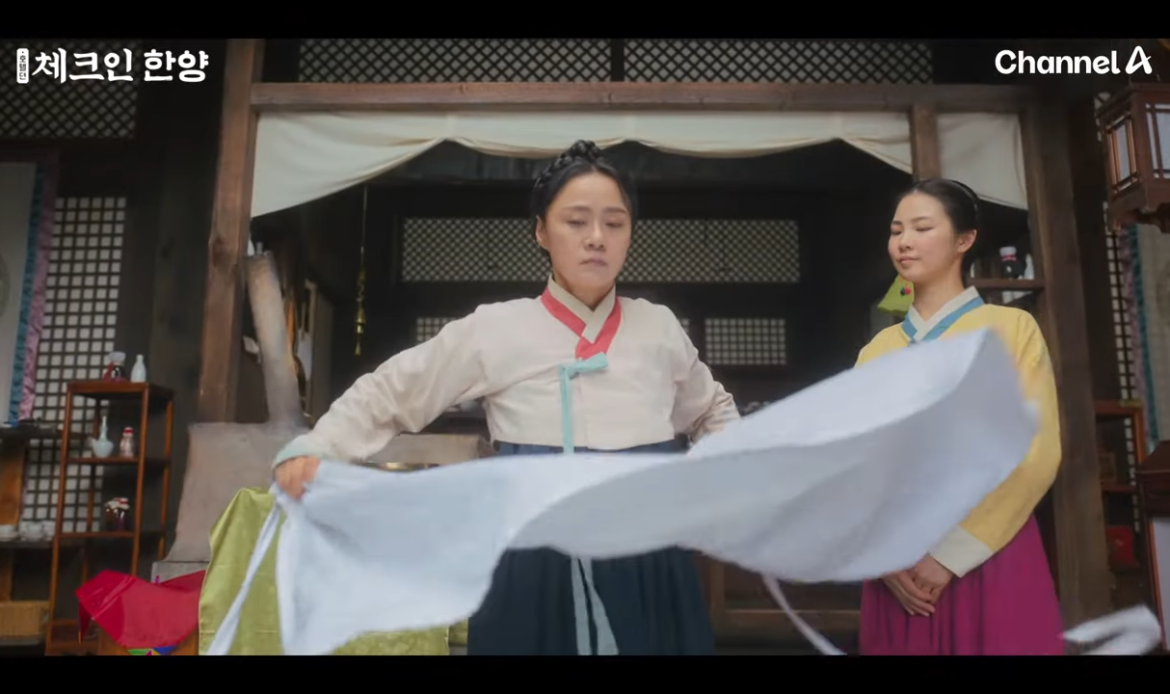At Yongcheonru, where Qing Dynasty envoys are staying, breakfast is served—but they are unimpressed with the soup. After multiple complaints from the envoys, the heads of both the hospitality and food preparation departments face an emergency.
Meanwhile, Deok-su’s mother, having enjoyed a delightful time at Yongcheonru at the invitation of Tae Sang Bangju, prepares a hearty bowl of gukbap (rice soup) for her daughter’s breakfast, knowing how much she loves it. When the head of the food preparation department tastes it, he is astonished by its refreshing and savory flavor. Seizing an opportunity, the head of the hospitality department secretly takes a portion of this gukbap and serves it to the Qing envoys.
To their surprise, the envoys are deeply moved, exclaiming that it tastes just like “the food their mother used to make.” Seeing this, the food preparation head quickly asks Deok-su’s mother to prepare 100 bowls of gukbap, effectively covering up the fact that they had taken Deok-su’s breakfast.

Gukbap – A Beloved Dish of the Common People
Gukbap is not a royal dish—it is a staple of the common people. It consists of rice mixed into soup and comes in various forms, such as sundae gukbap (blood sausage soup with rice), bean sprout gukbap, beef gukbap, and pork gukbap. The gukbap featured in Check-in Hanyang appears to be a beef gukbap, likely one with siraegi (dried radish greens), which adds a refreshing depth of flavor.
When people hear beef soup (soegogiguk), they might first think of a clear broth with sliced radish and beef. However, when rice is added to this soup, it becomes beef gukbap. There’s also a version where beef and siraegi are simmered together, creating a more robust, earthy flavor. Since the term beef gukbap can refer to different variations, it can be difficult to know exactly which type is being served without tasting it first. While recent menu labels try to clarify by specifying siraegi beef gukbap or beef gukbap, the general term beef gukbap remains the most widely used.

Gukbap at Yongcheonru?
Yongcheonru is the most prestigious guesthouse, akin to a luxury five-star hotel. Naturally, its dining halls serve the finest cuisine. So, can a dish traditionally associated with commoners be served in such a refined setting?
The beauty of Korean cuisine lies in its simplicity and depth of flavor. While gukbap may be a humble dish, its potential for refinement is limitless. Just as traditional street foods can be elevated into gourmet experiences, gukbap too has the ability to evolve into a sophisticated dish fit for fine dining.
Trying Local Cuisine While Traveling
When traveling abroad, people naturally want to experience authentic local cuisine.
If asked to name iconic Korean dishes among foreigners, galbitang (short rib soup) and bibimbap would likely top the list. While these are indeed beloved Korean comfort foods, they represent just a fraction of Korea’s diverse culinary heritage.
Visitors to Seoul often explore historic and cultural districts such as Gwanghwamun and Dongdaemun. Conveniently, these areas offer many opportunities to try authentic Korean food, with Dongdaemun Market, Gwangjang Market, and Kyungdong Market located nearby. In these markets, renowned gukbap restaurants are just around the corner.
However, the real question is: Which gukbap should you try?
Just as shoyu ramen, miso ramen, and tonkotsu ramen all fall under the category of ramen but have vastly different flavors, different types of gukbap offer completely distinct taste experiences. To fully appreciate its diversity, the best approach is to try a variety of gukbaps rather than just one type.
Since personal taste is highly subjective, recommending a single “best” gukbap is difficult. However, if one were to choose a baseline dish that best represents gukbap, beef gukbap would be the safest recommendation.
What Is Siraegi in Beef Siraegi Gukbap?
Many Koreans often confuse siraegi and ugeoji because they look quite similar, especially when added to gukbap. Since both are dried vegetables, they can be difficult to distinguish at first glance.
Siraegi: Dried Radish Greens
Siraegi refers to the dried leafy stems of radishes, known as mucheong in Korean. Traditionally, when making kimchi, radishes were used for kkakdugi (cubed radish kimchi), and their greens were sometimes discarded. However, in the past, all food was considered precious, so nothing went to waste. By drying mucheong, people could preserve it for long periods, ensuring they had vegetables even in winter.
Ironically, in modern times, siraegi has become a rare and valuable ingredient. Unlike the past, when most households made their own kimchi, today, many people simply buy it from supermarkets. Additionally, in modern apartments and urban homes, drying mucheong in the sun is no longer a common practice.
Whereas in the past, people dried mucheong to avoid wasting food, today, they buy dried siraegi because they want to eat it. We now live in a time where some people choose beef siraegi gukbap not for the beef, but because they crave the siraegi itself.
Then, What Is Ugeoji?
Both siraegi and ugeoji are dried vegetables commonly used in gukbap. The key difference is that ugeoji refers to dried outer leaves of napa cabbage instead of radish greens.
The word ugeoji literally means “gathering from the top,” referring to the outer leaves of napa cabbage. When making kimchi, these outer leaves are often removed because they are too tough and fibrous to absorb the salt properly. To make high-quality baechu (napa cabbage) kimchi, the outer leaves are typically discarded, leaving only the tender inner leaves.
Both siraegi and ugeoji originated as byproducts of kimchi-making—once considered leftovers, they are now seen as nutritious and valuable ingredients. In fact, studies suggest that drying vegetables increases their beneficial nutrients, making them even healthier than fresh greens.
Since neither siraegi nor ugeoji are raw vegetables, they are easier to digest and enhance the deep, rich flavors of gukbap.
If you can tell the difference between siraegi and ugeoji, you’re already halfway to understanding Korean food as well as a native!



